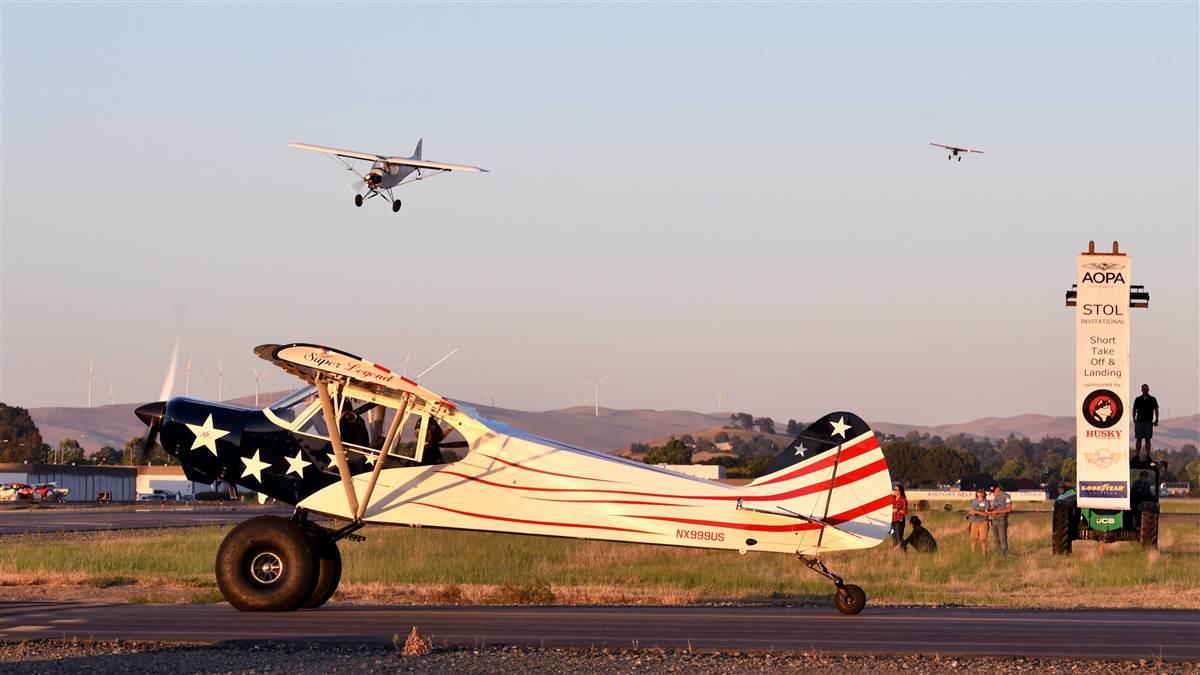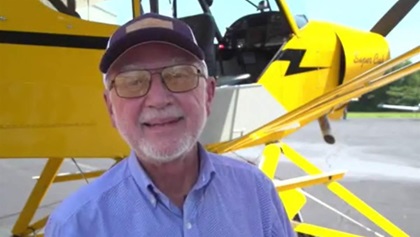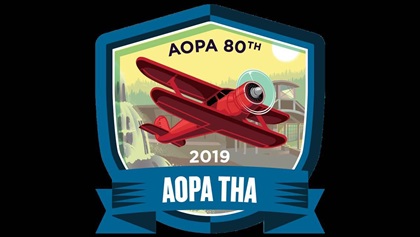
aopa.org/fly-ins
Living it up
AOPA Livermore Fly-In delivers
By Mike Collins
 Ask any visitor to AOPA’s Livermore Fly-In what was most memorable, there’s a good chance the answer would be short. Short field, that is. Many will remember watching Jimmy Gist, the “wrangler” for the AOPA STOL Invitational short takeoff and landing demonstration, coordinate masterful performances by 11 participating pilots just before the California sun set on June 21, and again at noon on June 22. Others might remember the weather, which was fantastic both days. Or the incredible opportunities for education and networking.
Ask any visitor to AOPA’s Livermore Fly-In what was most memorable, there’s a good chance the answer would be short. Short field, that is. Many will remember watching Jimmy Gist, the “wrangler” for the AOPA STOL Invitational short takeoff and landing demonstration, coordinate masterful performances by 11 participating pilots just before the California sun set on June 21, and again at noon on June 22. Others might remember the weather, which was fantastic both days. Or the incredible opportunities for education and networking.
Then again, any one of thousands of memories could make the list. With 9,790 people attending the two-day event, there are bound to be a range of answers—none of them wrong. The Livermore air traffic control tower and volunteer marshalers handled 431 aircraft during the event. Nearly one in three visitors attended a seminar or workshop. Presenters included Barry Schiff, a longtime AOPA Pilot columnist and contributor, who shared his “Nifty Tips for Safe Flying” with an audience almost filling the Main Stage tent on Saturday morning. Schiff, who has contributed to the magazine for 56 years, suggests that every pilot keep a second logbook. “In the second logbook I write down the mistakes I made on the flight I just took,” he said. “Nobody reads that logbook but me. Believe me, you can learn a lot from that.”
Marc Miller of Tiburon, California, was among the large crowd watching Saturday’s noon STOL demonstration. “It’s like a rocket ship,” he said as Draco, Mike Patey’s extensively modified—and Pratt & Whitney PT6-powered—Wilga climbed steeply. The Cessna 182 he flies doesn’t perform like that, Miller said. “It looks like a lot of fun. It puts the fun in flying.”
Friday night’s scheduled drone show was canceled because of software issues experienced by Great Lakes Drone Company. The issue resulted in a safety stand down by the drone operator. The night performance remains on the schedule for AOPA’s third and final 2019 Fly-In, which will take place in Tullahoma, Tennessee, September 13 and 14.
Email [email protected]
DETAILS: 9,790
The number of attendees at LVK, making it among the top-five attended fly-ins to date.

AOPA AIR SAFETY INSTITUTE
Dying art
Don’t forget the fundamentals
Every year, advancements in technology make flight planning easier and more efficient. Our electronic flight bags (EFBs) can plan and file for us, tell us when to start our descent, and even write a flight to our electronic logbooks if we choose. With the push of a button, glass cockpits pull up frequencies, runways, and crosswinds in organized, easy-to-read boxes. But if your EFB failed, are you sure you could read your backup paper chart and calculate performance on the fly? Do you have a backup chart on board? And if your GPS failed, could you navigate with a VOR and dead reckoning?
Your EFB and GPS probably won’t fail, but it’s always a good idea to be prepared for the unlikely event. Keep a current paper chart on board if you don’t already. Consider printing out airport diagrams for frequently visited fields or, if you’re planning a cross country, for airports en route. Write down the frequencies you know you’ll need and keep them nearby just in case. If you rely on an electronic flight bag for navigation, consider flying with an external battery.
As a pilot today, maintaining proficiency in VOR navigation and tracking may feel like being forced into mathematical computations on an abacus instead of a modern calculator. But the ground-based very high frequency omnidirectional ranges, while less relevant than before, aren’t dead yet.
Whether flying, driving or walking, GPSs are a regular part of most of our lives. Onboard GPSs are more complicated than, say, Google Maps, but the process of entering waypoints and following a line are similarly intuitive. Tuning and identifying a VOR—and verifying that you aren’t getting reverse sensing—is a multistep process that doesn’t have a common earthbound counterpart. Keep that skill sharp and you will stay further ahead of the airplane.
VOR navigation develops and improves single-pilot resource management. If you’re an instrument pilot, maintaining VOR navigation proficiency will help keep your rating current as well. If you aspire to be one, knowledge of intercept angles, wind correction, and VOR sensitivity will prepare you for instrument approaches in the future.
It is unlikely that your EFB or GPS will fail you, but you will need to be prepared in case the moment comes. And although the virtues of the VOR and tangible charts may not be initially apparent, developing and maintaining proficiency in navigation via radials and paper will make you a better, safer, and more prepared pilot.
Test your chart knowledge with ASI’s VFR sectional quiz.
airsafetyinstitute.org/quiz/vfrsectional
NOTICE OF ANNUAL MEETING OF MEMBERS
The annual meeting of the members of the Aircraft Owners and Pilots Association will be held at 9 a.m. on Wednesday, September 11, 2019, at the headquarters of AOPA, 411 Aviation Way, Frederick, Maryland, 21701, located on the Frederick Municipal Airport (FDK), for the purpose of receiving reports and transacting such other business as may properly come before the meeting, specifically including the election of trustees. If you are not able to attend, but would like to appoint your voting proxy, please visit aopa.org/myaccount or call 800-872-2672. —Kenneth M. Mead, Secretary
On your feed
Turn on your notifications
Fly with AOPA
Congratulations Wade!
 Didn’t win the Cub?! We got you! Sweeps Super Cub Winner Wade Shealy announces our next sweepstakes aircraft.....a Van’s RV–10.
Didn’t win the Cub?! We got you! Sweeps Super Cub Winner Wade Shealy announces our next sweepstakes aircraft.....a Van’s RV–10.
AOPA’s Pilot Passport: September challenge
Have you joined in the fun? More than 50,000 members have installed the AOPA app, which now features the AOPA Pilot Passport program. We’ve had more than 20,000 check-ins and those members have earned more than 7,000 badges. Participating pilots have also uploaded more than 1,500 photographs. This month, check in at airports that have designated events—such as the AOPA Fly-In at Tullahoma, Tennessee, September 13 and 14—for a chance to win an AOPA Pilot Gear prize package valued at $50. The top three check-ins with most event badges earned will win. We’ve also added new badges: historic airports (see p. 38), island airports, $100 hamburger (visits to restaurants on the field), and more surprise hidden badges. Every time you check in on the AOPA app, you earn points and progress toward badges. New challenges and new prizes are offered each month.
aopa.org/travel/pilot-passport

Looking for more?
Instagram: @flywithaopa, Twitter: @aopa, Facebook: AOPA: Your Freedom to Fly
Post of the month
 How to summer...
How to summer...
Picture by: @worldofmark
Use #flywithaopa for your chance to be featured!

Pilot Protection Services
Wires crossed
When you have to prove you met the deadline
By Chad Mayer
Any pilots who hold an FAA medical certificate, or who have had an application for a medical certificate deferred, may receive a letter from the FAA requesting additional information. The letter will often state, “we are unable to establish your eligibility to hold an airmen medical certificate at this time.” It also includes requests for medical records, tests, or other information to determine whether to approve or deny the application. In the case of an airman who already holds a medical certificate, the determination would be whether to refer a case to FAA legal counsel for possible suspension or revocation of that certificate if the FAA establishes that the airman is not medically qualified.
Generally speaking, the FAA has broad authority under FAR 67.413 to request additional medical information or history to determine whether a pilot meets the standards required to hold a medical certificate. Pilots are typically conscientious about responding to such requests within the 60-day deadline, but we recently have seen delays of up to 30 days for the Medical Certification Division to process mail.
AOPA’s Legal Services Plan has worked with pilots who have submitted all of the requested information by the deadline, only to receive a letter stating that the case has been referred for consideration of legal enforcement. On at least one occasion the pilot had proof of delivery by the deadline, but the FAA initiated a legal enforcement action in the form of an emergency order of suspension pending compliance with the FAA’s request for information. Evidently the office wasn’t aware that the request had been complied with because the responsive documents had not yet been scanned into the system.
Keeping detailed records, including proof of mailing and delivery, is of critical importance in resolving such an issue.
Chad Mayer is an in-house attorney with AOPA’s Legal Services Plan.


